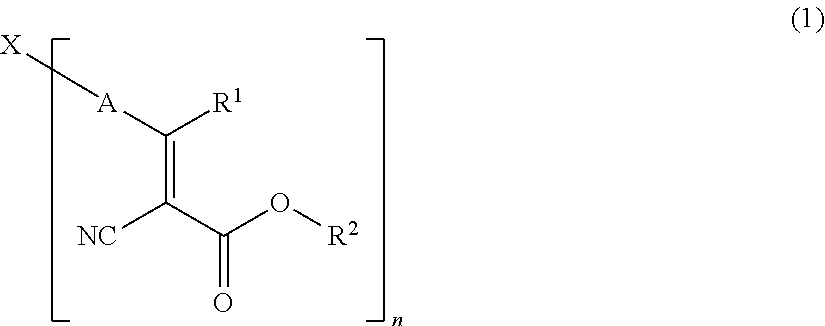NOVEL COMPOUND HAVING alpha-CYANOACRYLATE STRUCTURE, DYE, AND COLORED PHOTOSENSITIVE COMPOSITION
- Summary
- Abstract
- Description
- Claims
- Application Information
AI Technical Summary
Benefits of technology
Problems solved by technology
Method used
Image
Examples
example 1-1
Synthesis of Compound No. 1
[0177]Pyridine (10 g) was added to 2-hydroxyethyl 2-methylacrylate (1.30 g, 10 mmol), and 2-hydroxyethyl 2-methylacrylate was dissolved. After the atmosphere on the obtained solution was substituted by argon, EDC (2.87 g, 15 mmol) was added thereto, and the resultant was stirred at 40° C. for 0.5 hour in a reaction container. After the stirring, a solution of α-cyano-p-diethylaminocinnamic acid (manufactured by ADEKA Corporation: ADEKA ARKLS TD-4, 3.38 g, 15 mmol) in pyridine (4 g) was added dropwise to the reaction container. After the dropwise addition was completed, the resultant was reacted at 45° C. for 4 hours. Thereafter the reactant was cooled to room temperature and separated into two phases by adding ethyl acetate / water. The ethyl acetate phase was extracted, washed with water, dehydrated and concentrated, and purified by silica gel column chromatography (developing liquid: ethyl acetate). The powder obtained by the purification was washed by dis...
example 1-0.2
Synthesis of Compound No. 2
[0178]Dimethylformamide (18 g) was added to α-cyano-p-diethylaminocinnamic acid (manufactured by ADEKA: ADEKA ARKLS TD-4, 2.44 g, 10 mmol) and sodium hydroxide (0.4 g, 10 mmol), and α-cyano-p-diethylaminocinnamic acid and sodium hydroxide were dissolved. The resultant was reacted at room temperature for 1 hour. Thereafter 1-chloro-4-vinylbenzene (1.67 g, 11 mmol) was added thereto and reacted at 90° C. for 1 hour. Thereafter the reactant was cooled to room temperature and separated into two phases by adding ethyl acetate / water. The ethyl acetate layer was extracted, washed with water, dehydrated and concentrated, and subjected to recrystallization with ethyl acetate / hexane to give a solid. The obtained solid was dried to give 1.2 g of a yellow crystal (yield: 33.3%). It was confirmed by 1H-NMR and IR that the obtained yellow crystal was the intended product. Furthermore, the absorption wavelength property of the obtained yellow crystal was measured. The re...
example 1-3
Synthesis of Compound No. 3
[0179]Dimethylformamide (9 g) was added to α-cyano-p-diethylaminocinnamic acid (manufactured by ADEKA: ADEKA ARKLS TD-4, 2.44 g, 10 mmol) and sodium hydroxide (0.4 g, 10 mmol), and α-cyano-p-diethylaminocinnamic acid and sodium hydroxide were dissolved. The resultant was reacted at room temperature for 1 hour. Thereafter epibromohydrin (1.51 g, 11 mmol) was added thereto and reacted at 90° C. for 1 hour. After the reaction, the reactant was cooled to room temperature and separated into two phases by adding ethyl acetate / water. The ethyl acetate layer was extracted, washed with water, dehydrated and concentrated, and subjected to recrystallization with ethyl acetate / isopropanol to give a solid. The obtained solid was dried to give 1.02 g of a yellow crystal (yield: 34%). It was confirmed by 1H-NMR and IR that the obtained yellow crystal was the intended product. Furthermore, the absorption wavelength property of the obtained yellow crystal was measured. The...
PUM
| Property | Measurement | Unit |
|---|---|---|
| Photosensitivity | aaaaa | aaaaa |
Abstract
Description
Claims
Application Information
 Login to View More
Login to View More - R&D
- Intellectual Property
- Life Sciences
- Materials
- Tech Scout
- Unparalleled Data Quality
- Higher Quality Content
- 60% Fewer Hallucinations
Browse by: Latest US Patents, China's latest patents, Technical Efficacy Thesaurus, Application Domain, Technology Topic, Popular Technical Reports.
© 2025 PatSnap. All rights reserved.Legal|Privacy policy|Modern Slavery Act Transparency Statement|Sitemap|About US| Contact US: help@patsnap.com



